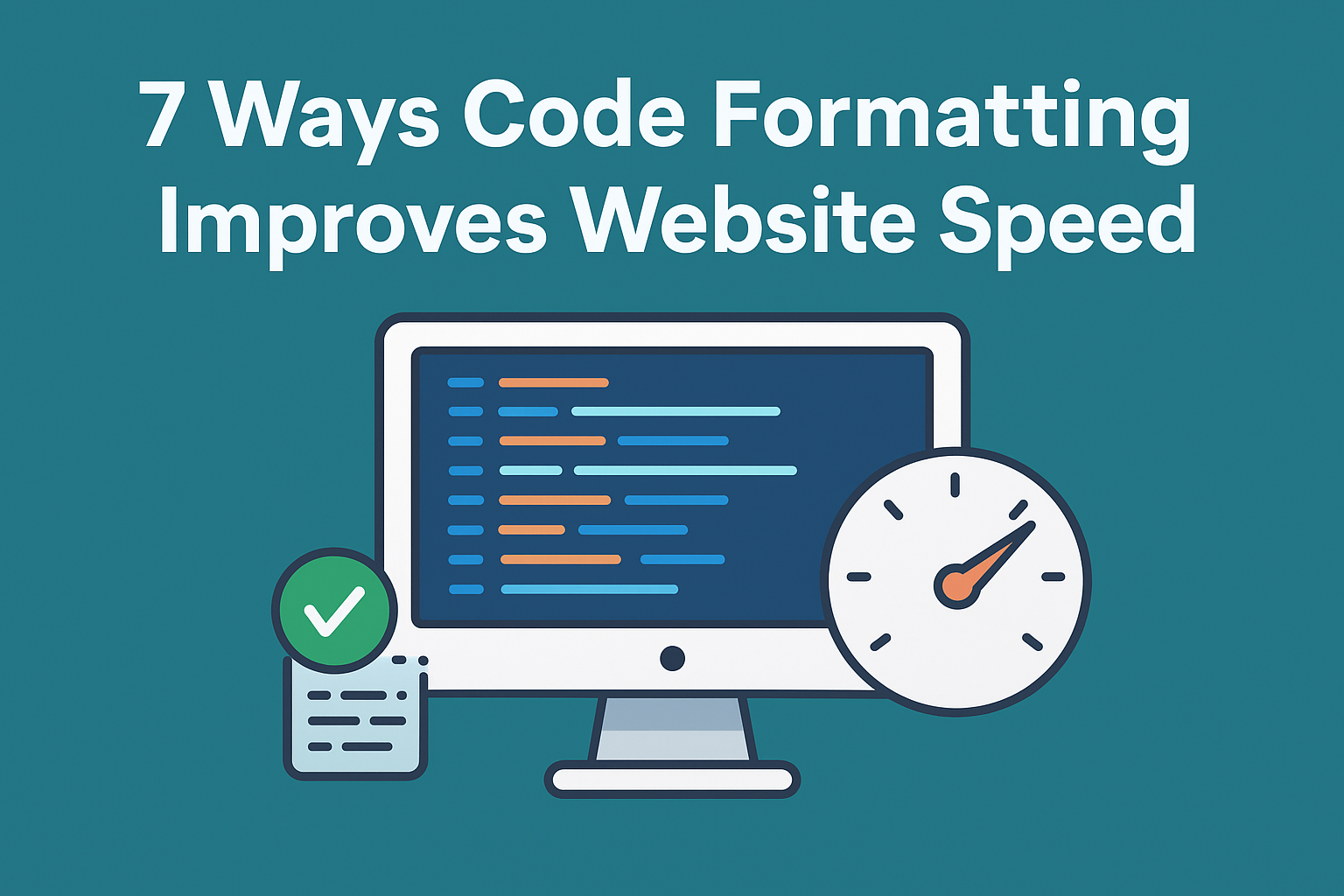Introduction:
Code Formatting Improves Website: Website speed is one of the most important factors for user experience and SEO today. A slow website can cause visitors to leave quickly and even impact your Google rankings. Many website owners focus on images or hosting, but overlook code formatting, a simple way to make websites load faster.
Clean and organized code can reduce load times, improve performance, and make your website easier to manage. In this guide, we’ll cover 7 ways code formatting improves website speed and share tips to implement them on your site.
What is Code Formatting and How Does It Affect Website Speed?
Code formatting refers to writing your HTML, CSS, and JavaScript in a neat and structured manner. Instead of messy, long lines of code, you break them into readable sections with proper indentation and spacing.
Well-formatted code is easier for developers to read and debug. It also helps browsers understand your website faster, which directly improves page load time.
Example:
- Unformatted CSS might be all in one line, making it heavy.
- Formatted CSS with proper spacing and indentation is lighter and loads faster.
Why Website Speed Matters in 2025
Website speed affects user experience, bounce rate, and SEO rankings. Slow websites frustrate visitors, causing them to leave before your content even loads.
Google uses Core Web Vitals to measure website performance. Faster websites are more likely to rank higher and get more traffic. Proper code formatting helps your site meet these speed standards by reducing unnecessary load time.
Step-by-Step Ways to Format Code for Faster Websites:
1: Minify and Format Code:
Extra spaces, tabs, and line breaks make your code files larger. Large files take longer to load, which can slow down your site.
Solution: Minify and format your HTML, CSS, and JavaScript. Smaller files load faster, improving website performance.
2: Reduce Render-Blocking Scripts
JavaScript files can sometimes block the page from loading. Properly formatted code allows scripts to load asynchronously or defer, which makes your pages appear faster to visitors.
3: Improve Browser Rendering
Browsers read code line by line. Messy code slows this process. Clean, organized code enables the browser to render pages more efficiently, providing visitors with instant access to content.
4: Optimize HTML, CSS, and JS for Speed
Well-formatted code compresses more efficiently with tools like GZIP or Brotli, resulting in a smaller file size. Clean HTML, CSS, and JS also make caching easier, so returning visitors experience faster load times.
5: Remove Redundant Code
Messy code often has duplicate or unused parts. Formatting makes it easier to identify and remove these, reducing the overall size and speeding up your website.
6: Structured Coding for SEO and Speed
Organized code reduces errors and conflicts with plugins or third-party scripts. This ensures your website loads smoothly and improves Core Web Vitals scores.
7: Format Code for Mobile Website Speed
Mobile users are susceptible to speed. Structured and properly indented code ensures your website loads quickly on all devices, improving user experience and SEO.
Tools to Format HTML, CSS, and JavaScript for Speed:
Here are some easy tools to clean and optimize your code:
- Prettier: Automatically formats your code in VS Code.
- RapidFreeFormatter: Online tool to organize HTML, CSS, and JS.
- Minifier Tools: Compress code to reduce load times.
- CodePen / JSFiddle: Test and format your code easily.
Using these tools ensures your website is fast, efficient, and professional.
Common Mistakes That Slow Down Your Website
- Writing all CSS or JS in one long line
- Using inline scripts and styles excessively
- Ignoring code minification
- Not organizing code for mobile responsiveness
- Failing to check third-party script conflicts
Correcting these mistakes with proper formatting can significantly improve your website’s speed.
SEO and Performance Benefits of Proper Code Formatting:
Formatted code doesn’t just make your site faster; it also improves SEO and overall performance:
- Enhances Core Web Vitals scores
- Improves Google PageSpeed Insights results
- Reduces server response time
- Provides better UX for visitors
- Helps your website rank higher in search results
Conclusion:
In Conclusion, Proper code formatting is one of the simplest yet most powerful ways to improve website speed. Clean, organized code helps browsers read and render your pages faster, reduces file sizes, and eliminates unnecessary delays. By following formatting best practices, such as minifying code, organizing HTML, CSS, and JavaScript, and removing redundant elements, you can significantly boost your site’s performance.
Faster websites not only provide a better experience for visitors but also improve SEO rankings, enhance Core Web Vitals, and increase engagement. Mobile users, in particular, benefit from structured code, as it allows pages to load quickly on any device.
Whether you are a developer or a website owner, investing time in proper code formatting can save you headaches and improve site efficiency. Start implementing these techniques today, and watch your website load faster, perform better, and deliver a smoother experience for every visitor.
Frequently Asked Questions (FAQs):
1. How does code formatting improve website speed?
Clean code is easier for browsers to read, reduces file size, and removes render-blocking elements.
2. What tools can I use to format HTML, CSS, and JavaScript?
Tools like Prettier, RapidFreeFormatter, and online minifiers make formatting simple and effective.
3. Can code formatting alone make my site fast?
It helps significantly, but combining it with image optimization, caching, and a good hosting plan yields the best results.
4. How often should I format my website code?
Whenever you update your website or add new features, regular formatting keeps your site fast and clean.
5. Does minification count as code formatting?
Yes, minification reduces extra spaces and file size, which is part of proper code formatting practices.

